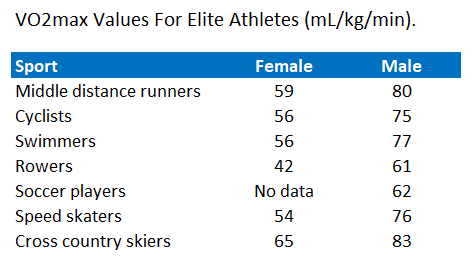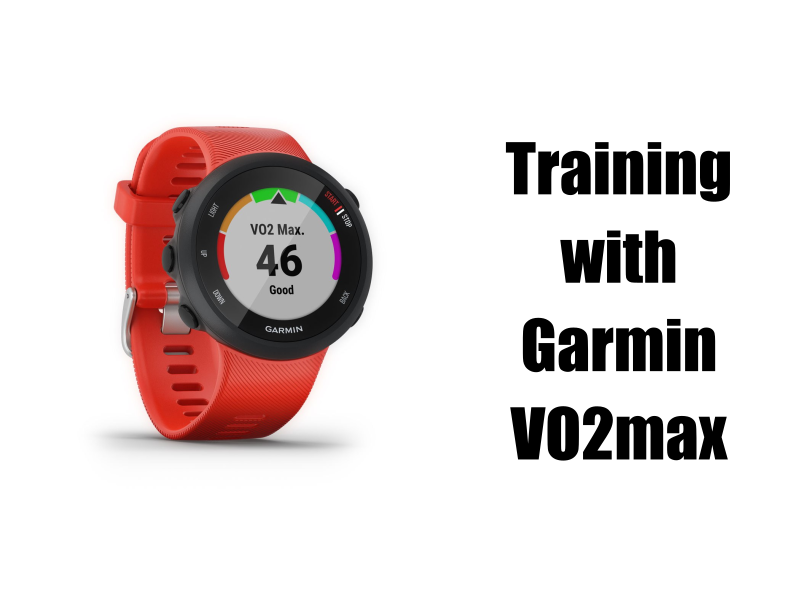What is Garmin VO2max and why is it important?
The Garmin VO2max feature makes it easy to measure and track this key metric. VO2max is the most accurate measurement of your cardio-respiratory fitness. It represents the maximum amount of oxygen your body can utilize.
Your body needs oxygen to burn the fuel that your muscles use to create power. As exercise intensity increases so does your uptake of oxygen. The faster you cycle or run then the more oxygen you need to use to sustain the pace.
There’s a level where your body simply can’t increase the amount of oxygen it uses even as the exercise intensity increases. This is your VO2max.
Your VO2max is your "aerobic ceiling". If exercise intensity increases after you have reached your VO2max your body starts to use anaerobic (without oxygen) pathways for energy production and lactic acid starts to accumulate. You can only continue exercising at that level for a few minutes at most.
To go faster for longer you need to increase your VO2max Garmin helps you do this.
VO2max as a fitness indicator
VO2max is an indicator of your overall physical fitness and incorporates aspects of your respiratory capacity, cardiovascular health and muscle fitness.
A decline in the performance of any of these systems will result in a reduced VO2max.
How is VO2max Expressed?
VO2max is commonly expressed in two ways:
Absolute VO2max: The total amount of oxygen your body can use. For example: 5.8 liters of oxygen per minute (5.8L O2/min).
VO2max per Kilo: VO2max in terms of body weight. For example: 53 milliliters oxygen per kilogram body weight per minute (or 53ml O2/kg/min). This is a more useful measure as it lets you compare your VO2max with other athletes.
What factors affect my VO2max?
There are 6 major factors that affect your aerobic power measurement:
Genetics
Genetics are believed to influence your VO2max by up to 20-30%. You can’t change your genetics but you can use DNA testing to find out if you are predisposed to a high or low VO2max and with this information you can adjust your training for optimal results.
Age
Above the age of 25 VO2max decreases by around 1% every year. Regular physical activity throughout your life will dramatically reduce this decline.
Training status
Athletic training can improve your VO2max by as much as 20% over time.
Sport Type
Measure an athlete's VO2max on a treadmill test, then a cycle test and finally in a swimming pool and the results will differ significantly because the muscles used for each activity have different oxygen requirements. Your body adapts to consume oxygen differently for each exercise and may be more or less optimized for each.
Treadmill running has been shown to produce the highest VO2max values.
Gender
Women generally have VO2max values that are 15-30% lower than men's. This takes into account differences in bodyweight. With a straight, like-for-like comparison the difference is even greater.
Body composition
Much of the differences in VO2max between men and women is attributed to body composition. Although there are other biologic differences between the sexes. Research also shows that VO2max decreases as body fat percent (BMI) increases.
How is VO2max usually measured?
There are two types of VO2max testing: Direct and Indirect.
Direct testing uses a gas analyzer to measure gas exchange directly while you exercise in a laboratory on a treadmill or turbo trainer. It’s very accurate but expensive.
Indirect testing estimates your VO2max based on your performance in a fitness test. It's less accurate but is a good option for most of us. Garmin VO2max estimates are based on indirect testing.
Both types of test can be maximal or submaximal. A maximal test involves exercising to exhaustion. A submaximal test lasts for a set period of time or distance and is more suitable for individuals who can't exercise to exhaustion for any reason.
Note: Knowing your VO2max on its own is useful. But it's far more useful if you know and understand you lactate or anaerobic threshold as well.
What is my ideal VO2max?
As with heart rate, there's no single "good" VO2 max. Your VO2max will differ from someone else's based on age, gender, fitness level and outside factors like altitude. For example:
- The average sedentary (inactive) male achieves a VO2max of about 35 to 40 mL/kg/min, and the average sedentary female scores approximately 27 to 30 mL/kg/min.
- Elite male runners have shown VO2 maxes of up to 85 mL/kg/min, and elite female runners have scored up to 77 mL/kg/min.
- A good VO2max for a 25-year-old male is 42.5-46.4 mL/kg/min, while a good value for a 25-year-old female is 33.0-36.9 mL/kg/min.
Here’s some more example of VO2max values for elite athletes:

How can I improve my VO2max
You can improve VO2max with mileage and interval training. Mileage focuses on the peripheral variables related to oxygen extraction and use, like mitochondrial and capillary volumes and aerobic enzyme activity.
Interval training focuses on the central variables related to oxygen delivery, like stroke volume and cardiac output. For experienced, well-trained athletes the intensity of training becomes paramount to improving VO2 max which is why HIIT training is so important.
How does Garmin estimate my VO2max?
This answer depends on the model of device that you have. Requirements will also vary based on the type of activity that is being recorded.
NOTE: Not all methods listed below will apply to your device. To determine what type of activity your device can calculate a VO2max Estimate for refer to your owner's manual.
VO2max Garmin Cycling Estimate
- Cycling activity must be 20 minutes or longer without stopping
- Heart rate data from either a built in optical heart rate sensor or from a chest strap (a chest strap will be more accurate)
- Heart rate must be elevated to 70% of your maximum heart rate
- A Power Meter is required
Cycling VO2max Tip: If you are having difficulty obtaining a cycling VO2max Estimate, try riding a course where you can maintain a steady effort for at least 20 minutes. You can also try using an indoor trainer.
VO2max Garmin Running Estimate
- Running Activity must be 10 minutes or longer in length (vivosport requires up to 15 minutes in length)
- Activity must be recorded outdoors with a GPS signal
- Heart rate data from either a built in optical heart rate sensor or from a chest strap (a chest strap will be more accurate)
- Heart rate must be elevated to 70% of your maximum heart rate
VO2max Garmin Estimate without GPS (for vivo compatible watches that do not feature GPS):
- Record a walk or running activity for at least 15 minutes in duration
Note: Brisk walking will provide a more accurate VO2max Estimate than running
- Hold your speed above 4km per hour (2.5 mph)
VO2max Garmin estimates not updating
This is one of the most common questions we see regarding Garmin VO2max measurements. There are three reasons that you might experience this phenomenon:
- The Activity didn’t meet the minimum time requirement
- Your heart rate wasn’t sufficiently elevated for the entire activity
- The activity didn’t meet the hierarchical rules for updating the results (See below)
Hierarchical rules for updating the results:
The Garmin philosophy is to display the most accurate measurement and we know that different exercise modes yield different results because of variations in muscle efficiency.
Running on a treadmill is proven to give the most representative value and Garmin consider “running outdoors with GPS” as the most accurate and so the number one priority in their hierarchy.
Here’s the full Garmin VO2max hierarchy and the logic for whether or not the overall VO2max Garmin estimate will be updated.
(Remember not all Garmin devices support all methods of VO2max estimation).
- Running Activity with GPS. (The most accurate overall VO2max estimate).
When you record a run activity with GPS which generates an overall VO2max Estimate the estimate will display in Garmin Connect, and for the next 30 days this can only be changed by any additional Run Activities with GPS that generate a VO2max estimate.
No other activity types can update the overall VO2max Estimate until the original estimate mentioned above is older than 30 days. This is because Running is at the top of the hierarchy list and takes preference over any other measurement for 30 days.
- Cycling Activity with a power meter.
When a measurement is achieved, this will always yield a Cycling VO2max measurement, even if there is also an overall VO2max measurement from #1 above.
- Walking Activity with GPS
When you record a Walking Activity with GPS which generates an overall VO2max Estimate then subsequently (Next day for example) you record a Run Activity with GPS which also generates an overall VO2max Estimate then the overall VO2max Estimate in Garmin Connect will be updated regardless of the age of the Walking activity because Running with GPS is the highest priority
- Walking during daily routine without recording an Activity
- Running Activity without GPS (using foot cadence as a speed estimate)
Which Garmin devices have Garmin VO2max?
These are the current Garmin devices that can estimate your VO2max. Not all devices support all training modes so make sure to read the manual to check your sport is included.
- Garmin Legacy Saga Series
- Garmin Legacy Hero Series
- Garmin vívoactive 4S
- Garmin vívomove Luxe
- Garmin Vívosmart 4
- Garmin vívosport
- Garmin Forerunner 245 Music
- Garmin Forerunner 45S
- Garmin Forerunner 645 Music
- Garmin Forerunner 935
- Garmin Forerunner 945
- Garmin Venu
- Garmin Fēnix 6
- Garmin Edge 130
- Garmin Edge 520 Plus
- Garmin Edge 530
- Garmin Edge 830
- Garmin Edge 1030


